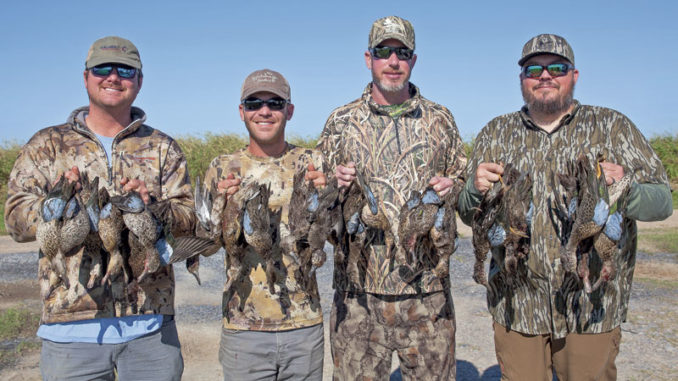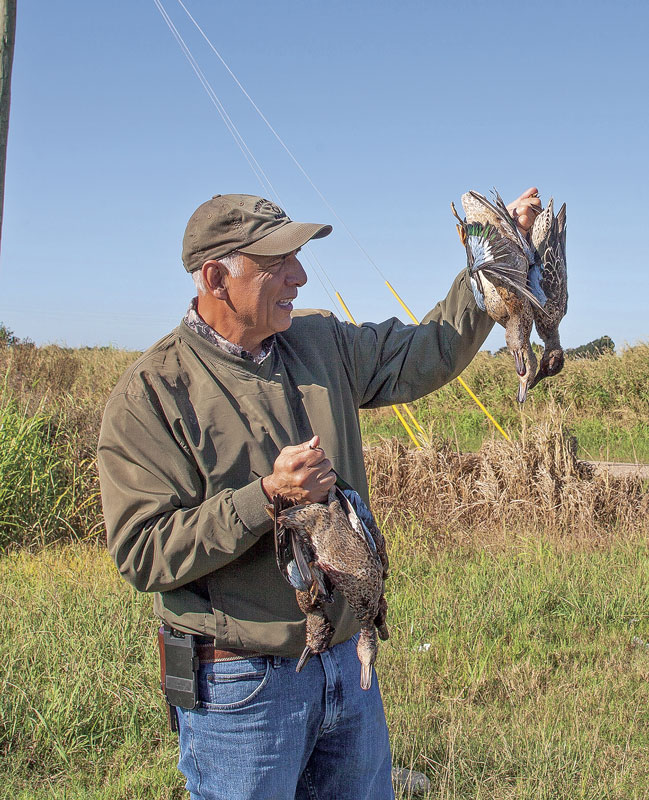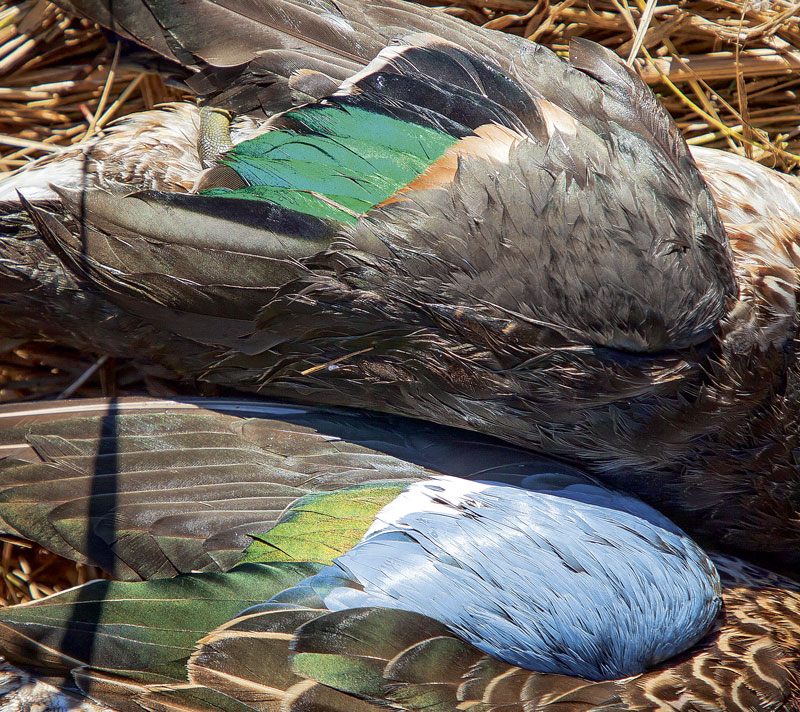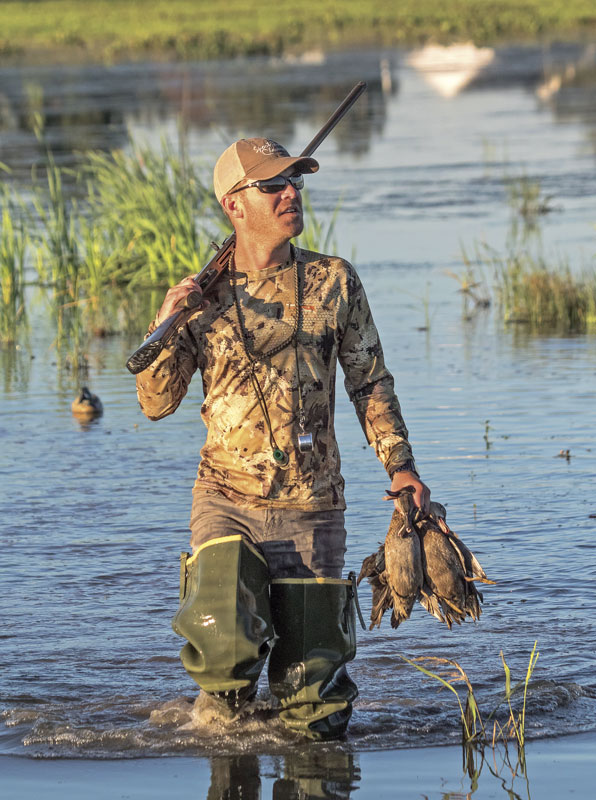
Solid advice on how to join the list of successful teal hunters
In late August, before the last notes of the accordion have faded, the lyrics of a French two-step song have been sung, and the Gueydan Duck Festival Queen has been crowned, blue-winged teal have already made up their minds to head south.
And because of their purposeful migration, perhaps there is no other place in the entire United States where there is as deep and rich a tradition for teal hunting than in Louisiana.
Number-wise the long-term average of teal that typically arrive by the first week to 10 days in September is around 227,000 birds statewide. And as such, some 92,000 Louisiana waterfowl hunters go to the marshes and rice fields annually to hunt them.
As recently as 2018, teal numbers arriving in the state plunged to a paltry 59,000 estimate, a number that was the lowest on record. However, since then, their numbers have somewhat rebounded.
During the 2021 Louisiana Department of Wildlife and Fisheries September aerial survey, 281,000 blue-winged teal were counted; a count that was 24 percent higher than their long-term average.
Yet, no matter how many teal are spread across the state annually, there are some hunters that tend to be more successful than others. Over the years they’ve hunted teal, they’ve also learned a few things. Little tricks, if you will, that have helped them put in many limits of birds on their game straps.
Three of those hunters are Johnny Wink from Jones in Morehouse Parish, Dale Bordelon from Deville in Avoyelles Parish, and Jack Cousin from Gueydan in Vermillion Parish.
North to south, whether agricultural fields, ponds, lakes, swamp, or marsh, these waterfowlers have made lasting impressions on those that share a blind with them. Moreover, they offer these thoughts and tips to novice or seasoned duck hunters who are looking for an edge or just maybe wanting to try something new.
 When to shoot
When to shoot
Johnny Wink, owner/operator of MegaBuck Duck Guides since 1974, was inducted in the Louisiana Chapter of Legends of the Outdoors Hall of Fame in 2019. For 47 seasons, he has seen a lot of teal fall into the decoys following a fusillade of shots from those he has guided. The reason for that is knowing when to call the shot.
“Let me tell you, I have watched countless-countless videos and television shows where these people wait until it’s too late to start shooting,” Wink said. “Teal are flying jet crazy and they’re boogie-boogie-boogieing and the people start shooting. By the time these ducks are about mid-ways over the decoys, it’s too late — they’re gone.
“Let’s say you’ve got your blind set up where the ducks will pass in front of you, and you’ve got ducks coming in from your right to your left. You have got to be able to predict what those birds are going to do. I want to call the shot before they’re over the first decoy to my right.”
Wink admits sometimes you’re going to lose, but more often than not, by the time everybody gets up, teal are in what he refers to as the ‘meat hole’ right out in front of the blind.
“They’re in that meat hole in the middle of the decoys versus at the outer edge going away from you,” Wink said. “You can shoot three times — boom-boom-boom — instead of maybe twice at birds already 30 to 40 yards out, past the decoys.”

Hunt where teal like to be
Another member of the Louisiana Chapter of Legends of the Outdoors Hall of Fame is Dale Bordelon, owner/operator of Bayou Beast Game Calls. At 61 years of age, Bordelon is popular on social media for his many videos that not only celebrate the Cajun culture, but also strive to maintain some of the older traditions he learned growing up; some as far back as a 100 years or more.
Bordelon duck hunts out of a handmade dugout pirogue that he made himself. He also utilizes his own hand carved decoys as well. In short, from equipment to the shotgun he uses, his style of hunting is reminiscent of an early twentieth century character right out of a scene from the 2013 movie Savannah.
Bordelon started hunting blue-winged teal in 1979 around Catahoula Lake. And, when it comes to teal, he also says there are places they prefer to be.
Bordelon, who hunts both public and private land, said, “We sometimes hunt these birds in a field in only about 3 to 4 inches of water. We kill 2 to 1 more birds in shallow water than deep water. So, I’m looking for shallow-shallow water. That’s where we hunt ducks if possible. In the lakes, you might have a good day today and you might not have another good day for five days. In that field, everyday it looks like you get some action. So, that’s the first thing I look for.”
Public lands like the Atchafalaya Delta WMA, which are tidal, are prime spots for targeting shallow water areas. This particular WMA has 3,250 acres of limited access areas where no motorized boats are allowed. By doing a little preseason scouting waterfowl hunters who walk in dragging a pirogue and decoys, can utilize Bordelon’s tip to their advantage, rather than hunt open water with one of the various surface drives.
From rice fields to pastures, shallow water areas can be found all over said Bordelon.
“Last year I went all around Elton and all over, and we made some good hunts,” he said. “We hunted a cow pasture one day after a big rain and those ducks were loaded up in that pasture. But, shallow water — that’s what I look for. It looks like everyone who’s got a little pothole, they do very well, especially when it’s shallow.”

When hiding from teal
Jack Cousin is a state and national waterfowl calling champion who makes his living as a full-time guide in southwest Louisiana. Jack’s reputation as a caller precedes him, where few go home disappointed after spending a morning in the blind with him.
Concealment is a critical part of waterfowl hunting. And, when it comes to blinds, Cousin is meticulous about this aspect whether a pit blind, A-frame, layout, or simply hiding in grass alongside a levee.
The question is, is concealment as critical with teal as it is with other ducks and geese? Cousin actually feels perhaps not, with maybe one exception.
“You still have to be still!” he said. “I mean concealment is not as important for teal hunting as it is with duck or goose hunting, but you still need it. When you’re hunting in September, obviously compared to November through January everything is green. So, even if you’re not in the most concealed blind, or even if you’re just levee hunting and they’re working, or you see them buzzing around, you definitely need to keep real still.”
Essentially, Cousin said a hunter may be able to sit on top of a levee without any vertical vegetation with teal moving and patrolling around and still get away with being exposed compared to other waterfowl just by remaining motionless.

To call, not to call, and motion decoys
Whether you’re hunting teal on private or public land, if you listen close enough, chances are the calling you’ll hear off in the distance will probably sound like a mallard. Not that that matters mind you, the question is do you need to call teal at all during the September season?
The answer is simply that it depends. In some cases it may help. In other cases calling doesn’t affect the outcome not one iota.
“You can kill teal with a regular mallard call, but I love to use a teal call,” Bordelon said. “My thing is, when we hunt in Catahoula we use a loud call, because you can see teal at a distance. In other words a long ways off. Once we get ‘em turned towards us, we hit ‘em aggressively with teal calls. We hit ‘em with a high pitch — ‘kak-kak-kak-kak’ — and we just stay on it.”
By contrast in the rice fields, where Cousin mostly hunts. He has mixed feelings about calling.
“Calling I don’t think plays as much of a vital role when hunting teal,” he said. “You don’t have to be a proficient teal caller — I don’t think — to kill teal in September, but it does help. There’s a few times when you can really turn them with a call and actually see it happen and you know that it was calling. But, I think between having mojos or some kind of motion de-coy out and knowing how to blow a teal call a little bit, is key too.”
Consider what you shoot
One of the things many waterfowl hunters don’t think of when going into the September teal season is the fodder they’re blowing out of the ends of their barrels.
Often times Cousin said, guys show up to hunt teal using the left over No. 2 shot size that they used on ducks and geese the previous year. And they’re shooting teal at 20 yards or less.
“There’s plenty of people that shoot their six teal in a box of shells,” Cousin said. “It happens all the time. But, if you shoot No. 4s at big ducks, get No. 6s for teal. For me, someone who is an average shot, it makes a huge difference when you put a higher percentage of steel shot in a pattern. Plus, the smaller shot doesn’t tear up the meat as much.”

Safety at all costs
The early September teal season is a harbinger for the up and coming big duck season in November. What’s more, guys tend to get pretty cranked up about hunting teal and are ready to do some shooting by the time this particular season rolls around.
Generally, whether hunting with friends or guiding a group of hunters, there are multiple people in the blind. And, this is where safety comes in.
“During teal season, I’m extra alert and more aware of everybody and what’s going on during the hunt,” Cousin said. “Whether hunting in a pit blind, an A-frame blind, or sitting on buckets brushed up along a levee, you’re hunting in a confined space. You need to have that one guy or leader — one person — to call the shot at all times. Because that way, everybody is on the same page when it’s time to go and not time to go.”
Cousin emphasized the importance to make sure everyone knows where the shooting lanes are and where you’re trying to shoot them every time, which is out over the decoys.
“It’s aggravating and dangerous,” Cousin said. “You want to make sure everyone knows this is where we’re all looking, so there’s not this guy in the back trying to make a crazy shot when they’re flying 40 miles per hour.
“When they make that swing with the wind right behind you and they almost take your hat off because you didn’t see them coming, somebody always wants to swing the opposite way and make a huge motion to shoot them. You’re never going to kill them like that and most likely they were going to come back. It’s just tough sometimes.”
Not everyone who hunt waterfowl are the same age, sex, size, or even in the same health.
“I’ve not only got to think about the birds, but I’ve got to think about the abilities of my customers,” Wink said. “I’ve got women in the blind, I’ve got kids in the blind, and I’ve got old people that just can’t get up like they did in their prime. The number one thing is to keep everybody safe in the blind.”
Teal season runs from Saturday, Sept. 10, 2022 through Sun-day, Sept. 25, 2022, with a daily bag limit of 6 and possession limit of 18 this year. With a little bit of luck and adding some of these tips, here’s hoping you’ll be putting a few blue-winged teal in the roasting pot.


